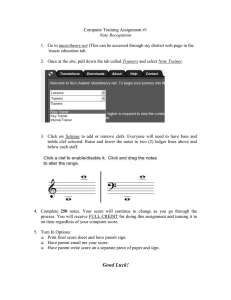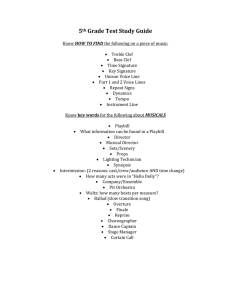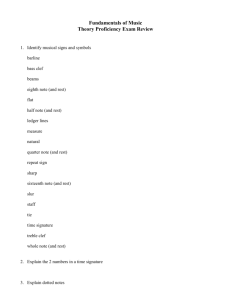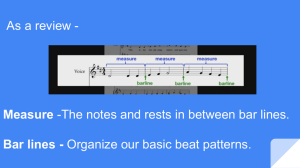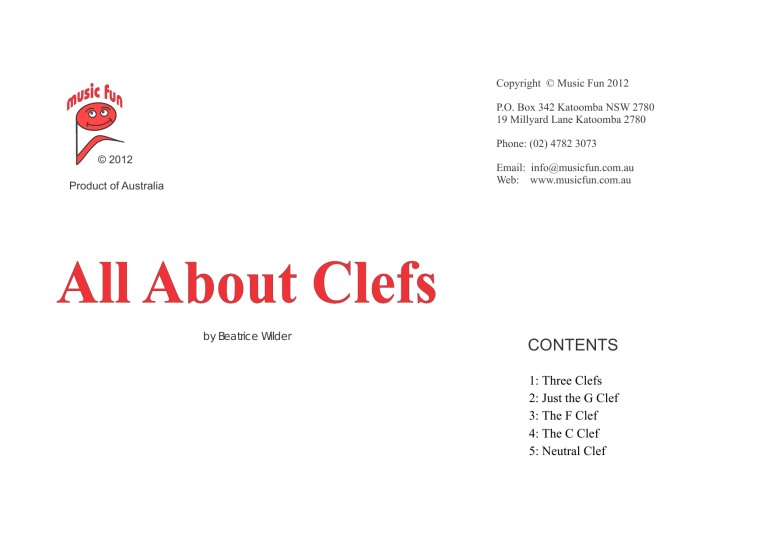
Copyright © Music Fun 2012 P.O. Box 342 Katoomba NSW 2780 19 Millyard Lane Katoomba 2780 Phone: (02) 4782 3073 © 2012 Email: info@musicfun.com.au Web: www.musicfun.com.au Product of Australia All About Clefs by Beatrice Wilder CONTENTS 1: Three Clefs 2: Just the G Clef 3: The F Clef 4: The C Clef 5: Neutral Clef All About Clefs 1. Three Clefs Some tracing and colouring practice: Here are some more strange looking ‘G’s. This is a G Clef It is meant to look a little like a G We usually refer to it as a ‘Treble Clef’ Can you see the shape of a ‘G’ in the G Clef? Here are some more strange looking ‘F’s. Some tracing and colouring practice: This is an F Clef It is meant to look a little like a F We usually refer to it as a ‘Bass Clef’ Can you see the shape of an ‘F’ in the F Clef? Here are some more strange looking ‘C’s. This is a C Clef It is meant to look a little like a C We usually refer to it as an ‘Alto Clef’ and sometimes a ‘Tenor Clef’ Can you see the shape of a ‘C’ in the C Clef? Some tracing and colouring practice: All About Clefs 2. Just the G Clef Imagine writing music on a staff like this one: Where’s G? Where’s F? It would be easier if you knew where ‘G’ was: Of course, our staves are five lines only and the G clef or Treble clef tells us that the line around which it curls is the G above middle C, also called G4. Copy another two treble clefs. G The word ‘Clef’ comes from an old Latin word meaning ‘Key.’ The letters ‘F’ and ‘C’ and ‘G’ were written on the staff as a ‘key’ to the names of the notes. The ‘G’ clef tells you which line is going to be ‘G’. The next G up from Middle C is called G4 because it is in the 4th octave on the piano. A piano usually has eight octaves. G1 G2 G3 G4 A B C D E F G A B C D E F G A B C D E F G A B C G5 G6 G7 D E F G A B C D E F G A B C D E F G A B C D E F G A B C Middle C is C4 Label all of the other C’s All About Clefs 3. The F Clef Before the modern F clef, the letter ‘F’ was simply written onto the staff. If we did that these days it might look like this: The F clef, or bass clef tells you where ‘F’ is going to be on the staff: The line that goes between the two dots on the bass clef is F3. This means that it is the ‘F’ below middle C Copy another two bass clefs. F Answer these: The bass clef is used on the bottom clef on the grand stave. The F Clef is also called the ............................................................ Trace the clefs on the grand stave opposite and label the notes correctly: The G Clef is also called the ............................................................ Label all of the F’s (F1 to F7) A B C D E F G A B C D E F G A B C D E F G A B C D E F G A B C D E F G A B C D E F G A B C D E F G A B C Middle C is C4 Circle the F indicated by the Bass Clef All About Clefs 4. The C Clef The C Clef tells you which line Middle C is on. It used to be drawn just as a ‘C’ Rather like this: These days like this: Then you know that Middle C is here: To draw a C clef yourself, start with two straight lines: Practice the C Curve: and put them together: C The C Clef is tricky! Here it is called an Alto Clef: Here it is called a Tenor Clef: These days, generally the only instrument using the alto clef is the: Viola but these can also use it: Alto trombone Oboe Some recorders Middle C Instruments that can use the tenor clef include: Cello Trombone Euphonium Bassoon Double Bass Middle C Practice tracing and copying the alto clef: Practice tracing and copying the tenor clef: All About Clefs 5. Neutral Clef This clef is used for percussion instruments of indefinite pitch. A different sort of clef altogether. It does not have a letter name. Both of these clefs are commonly used: Practice drawing the Neutral Clef: or Sometimes only one line is needed: Find another. Instruments you could use this for: Triangle Tambourine ......................................... Sometimes two lines are needed: Find another. Instruments you could use this for: Bongo Drums Congas ......................................... Percussion instruments with indefinite pitch: Add some of your own: Drums Woodblock Slapstick Guiro Triangle Castanets Some drum sets need lines and spaces for each drum so the composer would use five lines using note position as a guide to which drum to use, like this: bass drum snare drum low, mid and high toms
